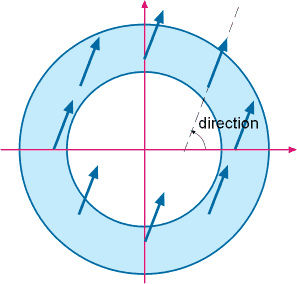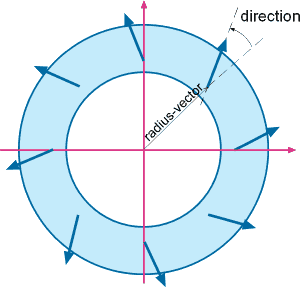

Cartesian
Polar
Permeability
Enter components of permeability tensor here, or leave None or blank to specify that the block with the corresponding label is excluded. To define two different components, first check the Anisotropic box. Choose Relative or Absolute to specify absolute values of permeability or relative to permeability of vacuum. With nonlinear materials, you need to define the magnetization curve, instead of magnetic permeability. Check the Nonlinear box to get into the B-H curve editor. If a B-H curve had already been defined, you would see a B-H Curve button that can be clicked to get into the curve editor.
Coercive Force of Magnet
Enter the magnitude and direction in degrees for the coercive force. Each of the values could be a number or a formula of coordinates and time. To specify linear or circular magnetization, select Cartesian or Polar coordinates respectively.
In case of Cartesian coordinates the angle is measured from the horizontal axis in the ounterclockwise direction. In case of Polar coordinates the angle is measured from the radius vector.
 |
 |
Cartesian |
Polar |
Conductivity
For transient problems, QuickField allows specifying non-zero electric conductivity in any block. In such case, it calculates the distribution of eddy currents in this block.
The electrical conductivity of the material can be a number of a formula or may depend on temperature. Dependency is given in tabular form and automatically be approximated by a spline.
To specify the electrical conductivity, which depends on temperature, check the Function of Temperature check box
to get into the curve editor.
Enter a number or a formula into the Temperature field. The formula describes the temperature dependency on time and coordinates. Please note that all coordinates in a formula are given in meters no regards to length units you have choose for the problem.
Field Source
Specify the kind of source (current density or total number of ampere-turns). If you have specified total current several blocks labeled with the same label would be considered as a single one or as conductors connected in serial depending on your choice. Serial conductors are carrying the same current and calculated current density could be different if their squares are not equal.
For transient problems, you can also define the field source in form of applied voltage (for blocks with non-zero electric conductivity) that can be time-dependent. To specify the voltage as a function of time, type the required formula in place of numerical value. Formulas are discussed in details in Working with Formulas section.
If the field analysis is performed with the electric circuit connected, then applied voltage or the full current for the solid conductor (with non-zero conductivity) cannot be defined in the label properties window. Instead of it, include all the conductive blocks into electric circuit with voltage or current sources attached to them. Only the parallel or serial connection of the separate conductors with the same label assigned should be defined in the label properties window.
Current density varies as 1/r
With axisymmetrical problems, if the total number of ampere-turns is specified you can check this box to define that current density in your coil varies inversely to the radius rather than being distributed uniformly. It might be closer to reality if your block represents a massive spiral coil.
Coordinates
Have sense for permanent magnets and anisotropic magnetics (also compound or laminated materials modeled as anisotropic). Specify Cartesian or Polar according to the class of symmetry of anisotropy and/or magnetization.
Related Topics
Formulations
Field sources